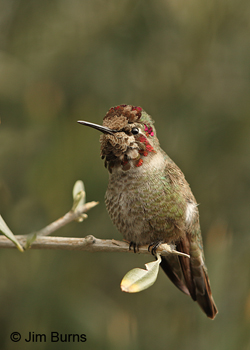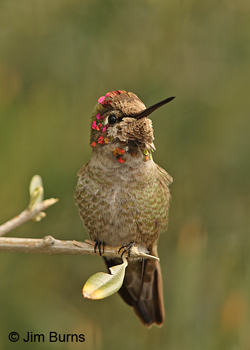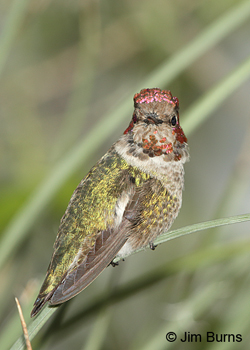
Annna's Hummingbird immature male

Annna's Hummingbird immature male

Annna's Hummingbird immature male
As a bird photographer I’ve always been fascinated by what I call “feather studies,” close ups of any species, any plumage, which show feather detail, and some of the most interesting ones I’ve taken involve the gorget and head feathers of immature male hummingbirds. From a distance these young hummers look blotchy and ragged, a visual disappointment next to spectacularly full plumaged adults. Up close, however, it’s a different story as you can appreciate from the photos accompanying today’s column.
When I first became interested in photographing birds, one of the first things I heard was to use flash on hummingbirds because it would “pop” their colors. It didn’t take long to realize this bit of advice was myth, not fact. Many species of birds have patches of iridescent feathers, none more spectacular than the hummingbirds. In his book Do Hummingbirds Hum? (a delightfully fun and informative read), my good friend George West explains that iridescent feathers are “those that shine brightly in sunlight and often change color depending on the angle at which you look at them.”
“The iridescent color is not the result of pigment absorption and reflection as in noniridescent feathers. The barbules of the iridescent part of the feather contain microscopic plates with elliptical air bubbles between them, and the amount of air in the bubbles creates different refractive indices that produce different colors depending on the angle of light hitting the feather and the position of the viewer.”
At present we have three male Anna’s frequenting our front yard, bathing and drinking from our fountain, and feeding at a feeder about three feet from my keyboard as I type this column. One of the males is doing the familiar dive display with an audible, sharp “Whop!” at the end, but surprisingly enough it is the immature male in the photos that is ruling the feeder and chasing away the two mature males.
We’ve all seen Anna’s gorgets look black and colorless only to have them “pop” to all the shades in the red gamut—rose, scarlet, maroon--if the bird looks in a different direction or changes his position. As a photographer I’ve learned to change my position if I’m not seeing any color at all. Sometimes this works, and every now and then I’ll even catch a fade from red into a dazzling, molten, golden green.
I’ve caught myself thinking of the color gaps on these ragged immatures as missing tiles on a tiled mosaic. The photos seen here are all the same individual, and you can see there are a few of the colored “tiles” representing all of the colors mentioned in the previous paragraph. The iridescence on the crown also changes, varying in color and intensity with the different sun angles.
It is reasonable to assume male hummers swivel their head position to “flash” passing females with their iridescence, an assumption corroborated by the “shuttle” display males perform in front of perched potential mates on the latter’s nesting territories. It is probable that head swiveling can also warn off male competitors investigating a displaying male’s territory. The bottom line is the fascination of knowing all three of the opening images are photos of the same bird, all taken within minutes of one another, all taken without moving the camera and tripod.